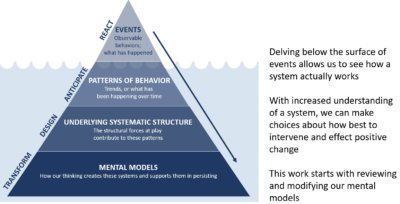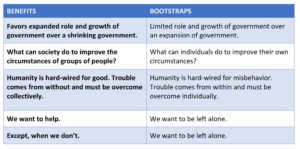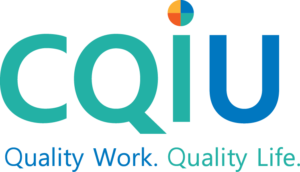Poverty and many societal problems faced today in the United States and around the globe are complex and interconnected. For example, children living in poverty are at greater risk for poor academic performance and retention; abuse and neglect; and behavioral, socio-emotional, and physical health problems (1). As we know, the challenges faced by individuals and families living in poverty rarely arise individually. And yet, our institutions and programs historically were designed to address a specific need or limited subset of poverty-related challenges. This approach has resulted in a collection of siloed poverty management programs instead of a true poverty reduction system.
Furthermore, change is a natural phenomenon we experience daily. Many of us can still remember when phones were tethered to the wall and mobility while on the phone was limited to the length of a telephone cord. We, as consumers, rapidly change our preferences, demanding increased technological innovation in support of improving the effectiveness or efficiency of our activities of daily living. The ongoing pressure for technological innovation, in consequence, drives global competition, transforming local economies and the nature of available jobs. In a world of complexity and constant change, linear thinking is insufficient.
Systems thinking is a foundational requirement for transformational leadership. Systems thinking is based on theory and methods used to optimize the performance of any collection of objects (e.g., in nature, society, or science) that are interdependent and work together to produce an outcome or result.(2) Optimization in systems thinking generally focuses on increasing the efficiency and/or effectiveness of a system in pursuit of a specific outcome or goal (e.g., reducing child poverty by 10% and having families reach 200% of the Federal Poverty Levels).
Systems theory explicitly acknowledges that perfect performance at the system level is unobtainable. Our goal, therefore, should be the creation of a learning system that is continually working to improve. System thinking, when more broadly viewed as a philosophy, can lead positive disruption towards changing the culture of an organization or system. Peter Senge described a learning organization as one “where people continually expand their capacity to create the results they truly desire, where new and expansive patterns of thinking are nurtured, where collective aspiration is set free, and where people are continually learning how to learn together.” (3)
In the Poverty Reduction Lab program, participants receive training and coaching to become adept at applying Continuous Quality Improvement (CQI) principals, methods, and tools. CQI, as a discipline, is fundamentally grounded in systems theory and the principles of creating a learning organization.
W. Edwards Deming, an American engineer, is one of the fathers of systems thinking and its application to continual improvement of quality in industrial systems. His early work, starting in 1950 in Japan, is credited as a primary driver of Japan’s post-World War II industrial recovery. His work directly contributed to Japan becoming a world economic power. (4) As an engineer, Deming focused on manufacturing applications. Today, CQI principles and methods are standard practice in industry. CQI methods and tools are used to ensure planes take off and land safely, our food and medicines are safe, and a size 12 pair of women’s slacks has a consistent waist circumference (OK, maybe more work is needed for that last one!).
CQI, as a discipline and management philosophy, has also broadly been adopted by service organizations, including in the fields of education, healthcare, and public health. Consequently, there is a strong evidence base in support of the benefits of creating a culture of quality and applying CQI methods and tools to optimize system efficiency and effectiveness. However, CQI might be a relatively new concept for public agencies and nonprofit organizations, at least as compared to the decades of experience in industry and healthcare. For many public and nonprofit organizations, the introduction to CQI arrives when a desired funding source requires it as a condition of receiving a grant or other financial award.
As staunch advocates for the transformative power of systems thinking and the discipline of CQI, CQIU (5) is consulting with Circles USA on Poverty Reduction Labs and other initiatives. Our goal, with you and other regional partners, is the development of a coherent, continually improving, poverty reduction system. CQIU has a combined total of more than 30 years of experience in supporting healthcare and social care organizations and networks begin the journey of culture change and implementation of CQI methods and tools.

Today’s problems are often yesterday’s solutions.
— Peter Senge
By focusing on events, we become reactive, seeing only the tip of the iceberg.(6) Instead, systems thinking leads us to transform our mental models and redesign underlying systematic structures. This change in mind-set and approach can then be leveraged to optimize a system, even when the system is immersed in a dynamic, seemingly chaotic, environment or seems intractably broken.
In practical application, systems theory can be applied at many levels. You, yourself, reside in a system, interconnected to others through work, home, family, friends, and the religious, civic, and social organizations in which you belong and participate. By examining your life as a system, you can more efficiently and effectively work toward having a happy, balanced life that follows your values and meets your goals, simultaneous to and in alignment with the development of a poverty reduction system in your community or region.
Darcey Terris Founder and Principal Consultant of CQIU Quality Work. Quality Life.
————————————————————
The content for this Blog Series is drawn from the Poverty Reduction Lab program, a collaboration with CQIU.
The program’s focus includes:
-
- Dismantling the poverty management system,
- Leading your community through the four stages of change, and
- Creating a pathway to end poverty.
To stay tuned, sign-up for The Big View Newsletter, our monthly bulletin about poverty research and policy change.
1 “Effects of Poverty, Hunger and Homelessness on Children and Youth,” American Psychological Association, available at: www.apa.org/pi/families/poverty.aspx.
2 Systems theory, as a general area of study, originated in part through the work of an Austrian biologist named Ludwig von Bertalanffy.
3 Source: “The Fifth Discipline by Peter Senge,” 1990 (updated in 2010). New York, NY: Random House.
4 Deming is often called the “father of the third wave of the industrial revolution.” The Deming Institute, www.deming.org.
5 CQIU includes the “U” in their name, as CQI is a universal approach that can be applied to address many of the seemingly intractable societal issues that public agencies, nonprofits, and businesses face on a regular basis.
6 Source: Adapted from “The Iceberg Model” by M. Goodman, 2002. Hopkinton, MA: Innovation Associates Organizational Learning.






